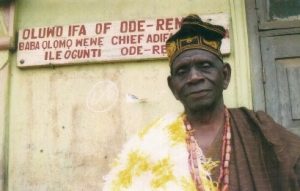Over the past 30 years I have had the good fortune to participate in many spiritual traditions, including Methodist Christianity, Islamic Sufism, Zen Buddhism, contemporary Paganism, Lakota ways and the Native American Church, Buryat Mongolian shamanism, and West African Ifá/Òrìṣà tradition. Despite tremendous diversity among these approaches to the sacred, some practice of prayer has been a strong thread of continuity.
In my experience, teachings on the underlying assumptions about prayer are often embedded in communal ritual. Below are five principles that seem to recur throughout diverse traditions. In sharing some basic observations from my lived experience in ritual, I’m not presuming to stand as a representative of these traditions, only to observe common themes surrounding the practice of prayer. If you already incorporate these approaches to prayer, consider whether there are ways that these principles could help you to bring even more vitality and embodiment to your practice.
Attend First to Your Personal State. We are multidimensional beings, capable of acting from places of more or less depth and alignment within ourselves. When I sit down at my shrines, I notice that taking a few minutes to ground and center can beneficially inform anything that follows. Likewise, when my heart is cracked open, after waking after a strong dream in the early hours of the morning, or during other kinds of dropped-in states, I’ve learned that these can be good opportunities to lean into spiritual practice.
Elders sometimes model this attentiveness to personal state before prayer in ways such as cleansing with water and smoke or by first asking for forgiveness before major prayers. While living as a practicing Muslim in North Africa, before each of the five daily prayers we would first wash with clean water as part of the prescribed ritual purification (wudu’ in Arabic). This habit of cleansing before prayer is deeply ingrained for the world’s billion and a half Muslims.
Years later while sitting in Native American Church ceremonies, I watched ritual officers regularly cleanse with cedar before speaking their prayers aloud for community. And after a long night of sitting up in sacred space, when the morning water was brought into the tipi to renew our lives and receive our prayers, I was moved to hear the water woman ask forgiveness from Creator as part of her process of entering into a state conducive to praying for the assembled community.
When approaching your personal practice of prayer, consider first giving extra attention to your personal state. In addition to cleansing with the smoke of aromatic herbs such as sage or cedar, ritual washing and bathing, and seeking forgiveness for past harms to self and others, explore intentional movement or breath practices to shift your attention to a more embodied place (e.g., more gut and less head). Notice which body position (e.g., sitting, standing, kneeling) helps you to stay dropped in during your prayers. Wearing intentional clothing, any significant talismans or sacred objects, and using ritually supportive oils, herbs, or other preparations may also help you to fully arrive before starting your prayers.
Pray in Connection with the Relevant Powers. Most traditions on Earth recognize many diverse spiritual forces or aspects of the Holy. Contemporary Pagans, whether working with Celtic, Norse, Egyptian, or other pantheons, tend to recognize and give reverence to at least a half dozen deities, if not considerably more. Even Muslims who passionately affirm God’s unity can invoke certain names of God that carry the qualities appropriate to one’s prayer (e.g., calling upon al-’Adl, the Just, when praying for legal victory). The unseen reflects this physical dimension. If I need food, I go to the grocery store, not just to any house on the block. If I need dental work, I seek out a dentist.
In Yorùbá tradition, I am an initiate of Ifá, Ọbàtálá, Ọ̀ṣun, and Egúngún in the lineage of Olúwo Fálolú Adésànyà of Òdè Rẹ́mọ, Ogun State, Nigeria. As is common in our tradition, I tend to approach certain powers for certain things. For example, if I’m concerned about blood family or helping someone transition to the next reality, I would approach the ancestors (Egúngún). If I’m praying for children, emotional healing, or sweetness in my relationships, these are all strong suits of Ọ̀ṣun, a deity of fresh water and fertility. For coolness and help with my public teaching, I may invite the counsel of Ọbàtálá, a patient and steady elder force. Ifá as a deity of divination is excellent at helping with the big picture and staying on track with my overall destiny. In addition to approaching the relevant deity or òrìṣà (all of whom also dwell within) to assist with my prayers, I may attempt to do the prayer work at a shrine consecrated for that divinity or seek out an initiate in that priesthood to further amplify the link.
Consider being mindful about which deities or aspects of the sacred you will approach to support your prayers. This may include praying with specific plants (e.g., tobacco, coca leaves), liquids (sacred waters, spirits), colorful cloth, etc. Give care to how you will enlist the assistance of these elder powers. Are there traditions or protocols for getting the attention of this deity or aspect of the divine? How do others who regularly work with this power go about it? If it’s a deity with whom you have long-term familiarity, you may already know how to approach. If your prayers call for a quality of energy or support that you’re not already in close relationship with, you may need to make extra effort to find the right people and places to support the effective realization of your prayers. Seek to feel their presence before speaking your prayers.

Pray Aloud with Clarity, Authenticity, and Vulnerability. Although there are many styles of prayer, and no single orientation is necessarily better than another, my elders in diverse traditions have consistently encouraged praying aloud. In Ifá/Òrìṣà tradition we ritually activate the tongue in recognition of the power of speech. This aligns with my personal sense that speaking our prayers out loud is more embodied, more connective, and more potent than only thinking them in silence. Prayers in our tradition tend to be heartfelt but also direct, concise, and focused. Ask succinctly and without apology for what you and your loved ones need for a fulfilled life here on Earth.
Praying aloud for what you really need and desire with community present can be a vulnerable ask. One way that folks dodge this intimacy is by praying only for general things like world peace and healing for the Earth. At times, those prayers may also come from a raw and vulnerable heart place, and it’s often the longing in our personal sphere that really cracks open the heart. Over fifteen years of participation in sweat lodges (often Lakota-style inipi ceremonies) those guiding the lodges consistently emphasized praying from the heart in a vulnerable and unscripted way.
What are the most courageous and vulnerable prayers you could possibly speak aloud? Are there prayers and longings you walk with that are hard to even admit to yourself? If you’re not sure what to pray for, ask to be profoundly in alignment with your personal destiny and soul-level calling. Pray for health and longevity and for the well-being of your family and loved ones. We are dependent on others, seen and unseen, for our survival, and prayer is one practice that invites us to speak honestly and openly from this reality.

Combine Your Asking with Generosity. Traditions that join prayer with the practice of making physical offerings tend to emphasize the importance of reciprocity, sacrifice, and “giving in order to get.” This is a nuanced topic both in terms of the forms that these offerings and sacrifice may take and the varied reasons for doing so.
For one, the powers called upon to help with one’s prayers may be ritually fed as a way to gain their favor and to honor their time and energy, much like we would pay a human contractor for an important project. In this way, offering tobacco or cornmeal as kind of “plant sacrifice” or ritual feast presented to the ancestors can be a way to invest energy into the relationship at a time when you are asking for their help.
Making offerings and personal sacrifices may also be viewed as a catalyst for the devotee to enter a state conducive to having their prayers realized (e.g., fasting during Lent or Ramadan). Intentional acts of generosity can also be linked with prayer based on the view that the merit or positive karma of the service can amplify the prayer itself. Buryat Mongol shaman Sarangerel emphasized that hiimori or “windhorse” is a kind of ritually usable energy that one builds up through acts of healing and service.
On a very practical level, offerings may increase the number of living human spirits present to support the ritual work. For example, during òrìṣà initiations in Nigeria, the four-legged animals offered to the deities become food for those present to support the ritual. Feeding more people leads to more folks praying for the initiate, which in turn leads to a stronger ritual.
If you don’t already associate prayer with the act of giving, consider exploring some basic work with physical offerings the next time you’re making important requests of the sacred. This offering could be as simple as a dish of water, a candle, or flowers. Let the choice of offering reflect the nature of your prayers or the preferences of the powers you’re calling upon for support. Find a way to give that feels right for you, and be sure to invoke the receiver of your gift before sharing your prayers and presenting your offering.
Be curious at a later date about the effect of the offerings you made and seek to refine this art of generosity in a way that is enjoyable for you, pleasing to the powers, and effective in amplifying the signal on your prayers.

Proactively Live and Embody Your Prayers. On the subject of what happens after making focused prayers, I’ve heard mixed advice. Some give an image like releasing an arrow and counsel that once your intentions have been ritually launched, the best strategy is to move forward in a spirit of faith and trust with no need to repeat the prayers. In short; stay receptive but trust that your prayers are being processed. Others characterize prayer as a kind of intention setting that requires regular reinforcement, repetition, and effort to come to fruition.
Of course these two perspectives are compatible; we are both active participants in shaping the course of our lives and prayers reverberate, often in unpredictable ways, through the web of relationships beyond our personal sphere. In this way, the period of time after strong prayers calls for both openness to the world’s response as well as attentiveness to your necessary role in a prayer’s fulfillment.
Consider over time the way that your life has already been shaped by the prayers you’ve made. Our words are powerful, and all the more so when coupled with clear ritual intent and established practices for amplifying prayer. As you find your groove over time and notice your practices bearing fruit, remember to give thanks to those who assist with the realization of your prayers and to continue honing the clarity and kindness of your words.
Prayer in this way is also a training ground that encourages increased responsibility and accountability with our everyday speech and actions. Find ways to keep your practice joyful and spontaneous, and return regularly to the core prayer to even more fully embody your personal gifts and fulfill your specific destiny during your time on Earth.




